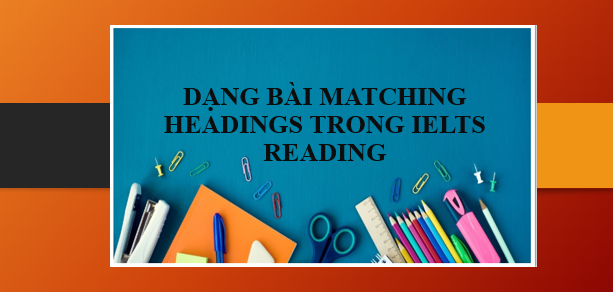A. Average results contradicted parental assessment of children’s knowledge.
B. Children who were post-tested using post-nominal adjectives performed well, regardless of the type of training.
C. Greatest levels of improvement were achieved by children who were trained and post-tested using post-nominal adjectives.
D. Some children performed less well in the post-test than in the pre-test.
E. Some children were unable to accurately name any of the colours in the pre and post-tests.
Bài 7:
ORGANIC FOOD: WHY?
By Rob Lyons and Jan Bowman
Today, many governments are promoting organic or natural farming methods that avoid the use of pesticides and other artificial products. The aim is to show that they care about the environment and about people's health. But is this the right approach?
A. Europe is now the biggest market for organic food in the world, expanding by 25 percent a year over the past 10 years. So what is the attraction of organic food for some people? The really important thing is that organic sounds more ‘natural’. Eating organic is a way of defining oneself as natural, good, caring, different from the junk-food-scoffing masses. As one journalist puts it: It feels closer to the source, the beginning, the start of things.' The real desire is to be somehow close to the soil, to Mother Nature.
B. Unlike conventional farming, the organic approach means farming with natural, rather than man-made, fertilisers and pesticides. Techniques such as crop rotation improve soil quality and help organic farmers compensate for the absence of man-made chemicals. As a method of food production, organic is, however, inefficient in its use of labour and land; there are severe limits to how much food can be produced. Also, the environmental benefits of not using artificial fertiliser are tiny compared with the amount of carbon dioxide emitted by transporting food (a great deal of Britain’s organic produce is shipped in from other countries and transported from shop to home by car).
C. Organic farming is often claimed to be safer than conventional farming - for the environment and for consumers. Yet studies into organic farming worldwide continue to reject this claim. An extensive review by the UK Food Standards Agency found that there was no statistically significant difference between organic and conventional crops. Even where results indicated there was evidence of a difference, the reviewers found no sign that these differences would have any noticeable effect on health.
D. The simplistic claim that organic food is more nutritious than conventional food was always likely to be misleading. Food is a natural product, and the health value of different foods will vary for a number of reasons, including freshness, the way the food is cooked, the type of soil it is grown in, the amount of sunlight and rain crops have received, and so on. Likewise, the flavour of a carrot has less to do with whether it was fertilised with manure or something out of a plastic sack than with the variety of carrot and how long ago it was dug up. The differences created by these things are likely to be greater than any differences brought about by using an organic or non-organic system of production. Indeed, even some ‘organic’ farms are quite different from one another.
E. The notion that organic food is safer than ‘normal’ food is also contradicted by the fact that many of our most common foods are full of natural toxins. Parsnips cause blisters on the skin of agricultural workers. Toasting bread creates carcinogens. As one research expert says: ‘People think that the more natural something is, the better it is for them. That is simply not the case. In fact, it is the opposite that is true: the closer a plant is to its natural state, the more likely it is that it will poison you. Naturally, many plants do not want to be eaten, so we have spent 10,000 years developing agriculture and breeding out harmful traits from crops.'
F. Yet educated Europeans are more scared of eating traces of a few, strictly regulated, man-made chemicals than they are of eating the ones that nature created directly. Surrounded by plentiful food, it’s not nature they worry about, but technology. Our obsessions with the ethics and safety of what we eat - concerns about antibiotics in animals, additives in food, GM crops and so on - are symptomatic of a highly technological society that has little faith in its ability to use this technology wisely. In this context, the less something is touched by the human hand, the healthier people assume it must be.
G. Ultimately, the organic farming movement is an expensive luxury for shoppers in well-manicured Europe. For developing parts of the world, it is irrelevant. To European environmentalists, the fact that organic methods require more labour and land than conventional ones to get the same yields is a good thing; to a farmer in rural Africa, it is a disaster. Here, land tends to be so starved and crop yields so low that there simply is not enough organic matter to put back into the soil. Perhaps the focus should be on helping these countries to gain access to the most advanced farming techniques, rather than going back to basics.
Adapted from articles in Spiked
Choose TWO letters, A-E
Question 8-9
Which TWO of the following points does the writer mention in connection with organic farming?
A. the occasional use of pesticides
B. using the same field for different crops
C. testing soil quality
D. reducing the number of farm workers
E. the production of greenhouse gases
Questions 10-11
According to the writer, which TWO factors affect the nutritional content of food?
A. who prepares the food
B. the weather conditions during growth
C. where the food has been stored
D. when the plants were removed from the earth
E. the type of farm the food was grown on
Questions 12-13
Which TWO negative aspects of organic farming does the writer mention?
A. Consumers complain about the extra cost.
B. Organic food may make people ill.
C. Farm workers have to be specially trained.
D. It requires too much technological expertise.
E. It is not possible in some countries.
Bài 8:
HUMPBACK WHALE BREAKS MIGRATION RECORD
A whale surprises researchers with her journey.A lone humpback whale travelled more than 9,800 kilometres from breeding areas in Brazil to those in Madagascar, setting a record for the longest mammal migration ever documented.Humpback whales (Megaptera novaeangliae) are known to have some of the longest migration distances of all mammals, and this huge journey is about 400 kilometres farther than the previous humpback record. The finding was made by Peter Stevick, a biologist at the College of the Atlantic in Bar Harbor, Maine.The whale’s journey was unusual not only for its length, but also because it travelled across almost 90 degrees of longitude from west to east. Typically, humpbacks move in a north-south direction between cold feeding areas and warm breeding grounds - and the longest journeys which have been recorded until now have been between breeding and feeding sites.The whale, a female, was first spotted off the coast of Brazil, where researchers photographed its tail fluke and took skin samples for chromosome testing to determine the animal's sex. Two years later, a tourist on a whale-watching boat snapped a photo of the humpback near Madagascar.To match the two sightings, Stevick’s team used an extensive international catalogue of photographs of the undersides of tail flukes, which have distinctive markings. Researchers routinely compare the markings in each new photograph to those in the archive.The scientists then estimated the animal’s shortest possible route: an arc skirting the southern tip of South Africa and heading north-east towards Madagascar. The minimum distance is 9,800 kilometres, says Stevick, but this is likely to be an underestimate, because the whale probably took a detour to feed on krill in the Southern Ocean near Antarctica before reaching its destination.Most humpback-whale researchers focus their efforts on the Northern Hemisphere because the Southern Ocean near the Antarctic is a hostile environment and it is hard to get to, explains Rochelle Constantine, who studies the ecology of humpback whales at the University of Auckland in New Zealand. But, for whales, oceans in the Southern Hemisphere are wider and easier to travel across, says Constantine. Scientists will probably observe more long-distance migrations in the Southern Hemisphere as satellite tracking becomes increasingly common, she adds.Daniel Palacios, an oceanographer at the University of Hawaii at Manoa, says that the record-breaking journey could indicate that migration patterns are shifting as populations begin to recover from near-extinction and the population increases. But the reasons why the whale did not follow the usual migration routes remain a mystery. She could have been exploring new habitats, or simply have lost her way. 'We generally think of humpback whales as very well studied, but then they surprise us with things like this,’ Palacios says. ‘Undoubtedly there are a lot of things we still don’t know about whale migration.’
By Janelle Weaver, published online in Nature
Question 1-7
1. What TWO aspects of the whale’s journey surprised researchers?
A. the destination
B. the direction
C. the distance
D. the reason
E. the season
2. The passage mentions reasons why whales generally migrate. What TWO reasons are given?
A. to avoid humans
B. to be safe
C. to eat
D. to keep warm
E. to produce young
3. What TWO methods did researchers use to record the identity of the whale near Brazil?
A. They analysed part of the whale’s body.
B. They marked its tail.
C. They made notes of its behaviour.
D. They recorded the sounds it made.
E. They took a picture.
4. The passage mentions places the whale may have passed close to on its journey. Which TWO places may the whale have passed?
A. Antarctica
B. Hawaii
C. Maine
D. New Zealand
E. South Africa
5. The passage says that more research is done in the Northern Hemisphere. Which TWO reasons are given for this?
A. It contains more whales.
B. It has friendlier surroundings.
C. There are more samples available.
D. It is easier to reach.
E. It contains smaller whales.
6. The passage suggests why the whale made a different journey from usual. Which TWO reasons does it suggest?
A. She did not know where she was going.
B. She did not want to breed.
C. She wanted to escape a danger.
D. She was looking for a new place to live.
E. She was recovering from an illness.
7. Which TWO methods of finding out where whales migrate are mentioned in the passage?
A. attaching radio transmitters
B. comparing pictures taken in different place
C. following them in boats
D. placing cameras in key positions
E. following their movements from space.




